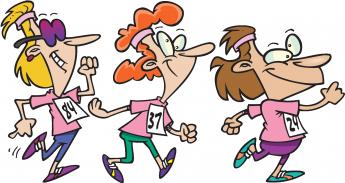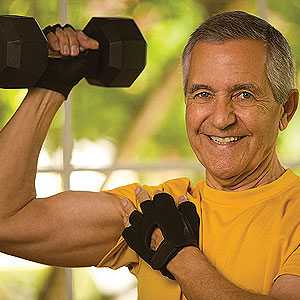Related Topics
Old Age, Re-designed
A grumpy analysis of future trends from a member of the Grumpy Generation.
Right Angle Club 2010
2010 is coming to a close, a lame-duck session is upon us, and probably after that will come two years of gridlock. But the Philadelphia Men's Club called the Right Angle, keeps right on talking about the current scene. A few of these current contents relate to speeches given elsewhere.
Exercise As Fun

|
| Exercise Against Resistance |
Almost every retirement community, cruise ship, and the large hotel have a "fitness center", so there really is no excuse for retired people to be as weak and flabby as they generally are. Arthritis is pretty common, but it is ordinarily so mild that taking a large aspirin or a small Ibuprofen tablet will cause you to forget about arthritis pain long enough to get some exercise. Stretching exercises will often get rid of what pain remains, and you should feel better as a consequence, not worse. All sorts of good things happen when older people start getting regular exercise; but if you are really crippled, the following is not written for you.
A friend who regularly "goes back" to Princeton reunions reports that about half of his class was still alive for the 60th reunion this year. Unfortunately, only eight members of the class were able to walk in the parade. The rest rode in golf carts. Speaking with the understandable bias of a Yale alumnus, I have to say this sort of thing is not necessary at all.
Almost everyone graduates from high school in pretty good condition, and the majority of college graduates are pretty fit at the time of graduation, too. Speaking from the vantage point of the 60th reunion, the fellows who were the athletic campus heroes are generally the ones who have serious hip, knee and shoulder disabilities which become fairly troublesome by the time of their retirement from the workforce. Either that or they soon regale you with stories of their artificial joint replacements. Nevertheless, it is curious that these are the class members who keep up their exercise in some way, usually golf or tennis, sometimes sailing; it almost seems as though it should be mandatory to learn golf or tennis in college, so that by the time retirement comes along, exercise has become a lifetime habit. That even seems to be true of the ones in golf carts because of football injuries in the past, but scientific studies don't seem to have established whether vigorous football, baseball or polo as a youth make you pay too great a price in later life; it would be interesting to know the overall trade-off.
The majority of Americans have a different life pattern and must be urged to change it. After they get married and have a steady job, they abandon exercise pretty completely. A few games on weekends, perhaps, and vigorous summer vacations for a few years in their 30s and 40s. After that, there is essentially no exercise at all, a steady gain of weight ("My, don't you look good,") and if they are lucky, no major illnesses until they retire. The fact is, most people don't much enjoy exercise, and arrive at retirement age with the bravado boast they haven't had much exercise for thirty years. Even the medical profession has abandoned them; doctors tell them that exercise is good for you, a most unwelcome scientific opinion.

|
| Combatting Sarcopenia |
Let's simplify some of the confusion which abounds among trainers and physiotherapists, about the various competing types of exercise. There are three types, and you need all three of them. First, you need to overcome the decades of disuse atrophy which come from endlessly sitting at a desk. The muscles get thin and withered, a condition which luxuriates in the descriptive term "sarcopenia". Start out with about six weeks of the kind of exercise a lot of people say you shouldn't have, the weight-lifting variety, chin-ups, and push-ups, possibly Charlie Atlas-type of pushing one hand up while pushing the other one down, or pushing one foot against another. That's sometimes called "Dynamic Tension". The purpose of all this is to build muscle size or bulk. The professional athletes who look so grotesque with their shirts off tend in addition to resort to self-medication with a mixture of testosterone and growth hormone, but that's not advised for them or for you. It may be that thirty years of administering illicit muscle-building hormones will prove to be statistically harmless, but right now it doesn't seem exactly a wise or harmless thing to do. The professional athletes imagine they can make many millions if they just get a small edge on their competitors, and after that, they can retire in luxury. Even if that dubious claim eventually proves to be true for them, it isn't true for most of the rest of us. If someone is as emaciated as a concentration-camp survivor, perhaps hormones are justified, but it is only wise to undertake it under a doctor's supervision, and only for a few months.
After the muscles have been bulked up for a month or two, perhaps longer if you are incorrigibly lazy, it is time to go to stretching and platform building. Some effort should be made to rotate muscles of the whole body, particularly if there is still an appreciable amount of muscle soreness for a day or two after each session. This is the time for a gym with a dozen different types of machines, each one aimed at a different muscle set. The magic number is five; stretch and pull each muscle group five times and then go to another; usually, it's five times on each side of the body or ten times per machine. Take an aspirin or ibuprofen before each session, and drink at least a glass of liquid afterward. Three times a week is often enough for a beginner to get started; but remember if you give yourself a month's vacation, it will take another month of hard work to get back to 80% of what you had only recently achieved.
After six months or so of this drill, start building endurance. A stationary bicycle, a treadmill, or swimming pool laps are useful for almost anyone. Running on a track is fine, but the majority of retirees have enough arthritis somewhere that they have to be careful about jogging. If the pain appears while doing this, especially chest pain, stop immediately.
A word about shoes. People with ankle injuries, chronic flat feet, or arthritis in the feet and ankles may well find they can't get any endurance exercise because their feet hurt. Before rushing into bunion surgery or some other drastic response, try some foam rubber shoes. These were once special-ordered by a famous seven-foot professional basketball player, who wanted to be three inches closer to the basket when he threw the ball. So, three inches of foam rubber was glued to the sole of his running shoes. Well, you trip if the edges aren't trimmed at the heels and toes, so various other small modifications evolved. Eventually, a commercial version emerged in which the foot is essentially encased in foam rubber, and after walking on them for a couple of weeks, the rubber gets crushed down appropriately. The effect is a molded shoe, just like molded ski boots, with crushed foam rubber instead of fiberglass. Quite often, the effect is to push the bones back into ideal arrangements, with dramatic relief of the chronic pain. If your feet don't hurt, you walk more, maybe even start to jog. During the first few weeks, be careful, or you may stumble and fall on your nose. After a month, you'll forget you have them on, and maybe even forget your feet used to hurt. Progress can be measured by the ability (usually after six weeks or so) to put on regular shoes for a day. Without pain.
Originally published: Saturday, June 12, 2010; most-recently modified: Thursday, May 16, 2019